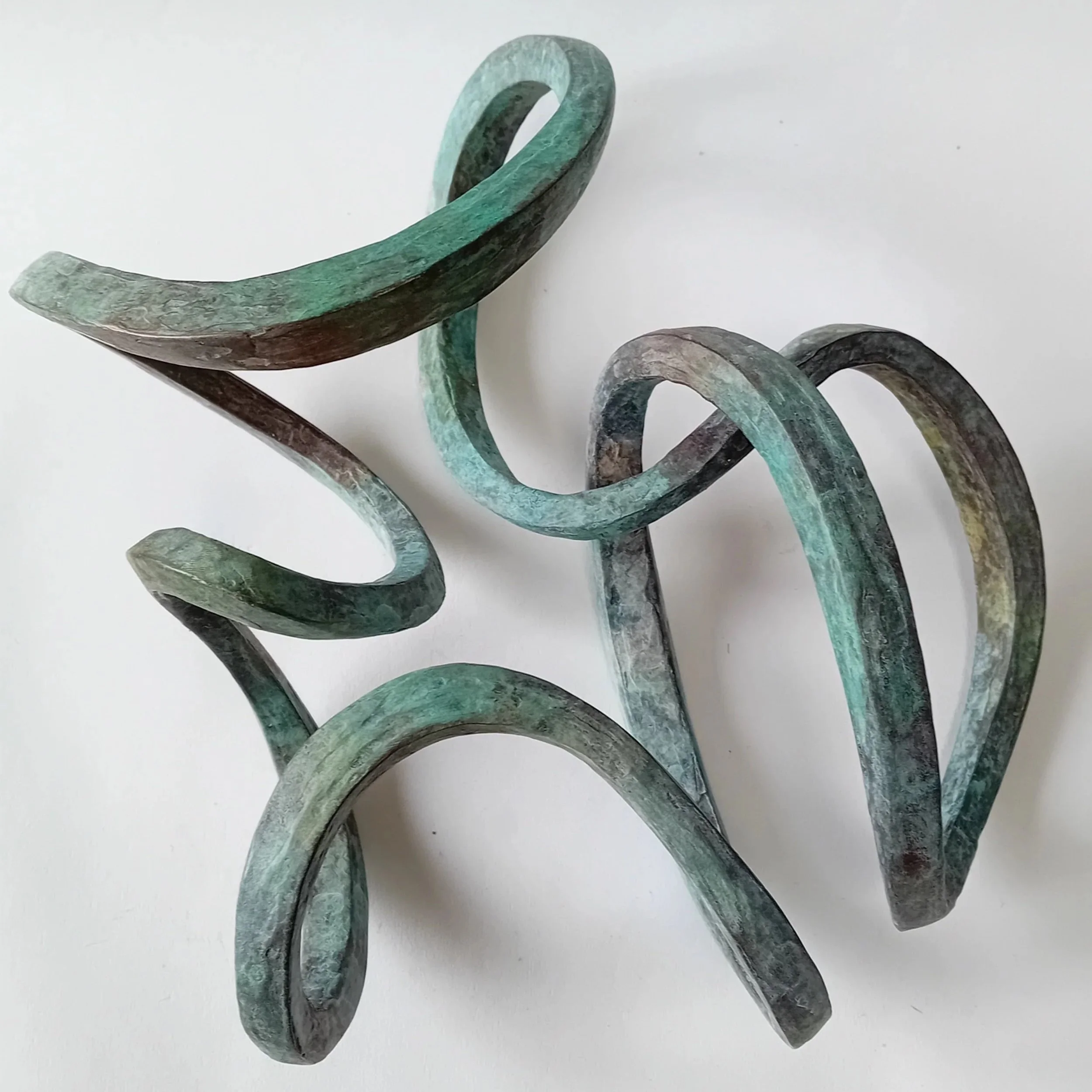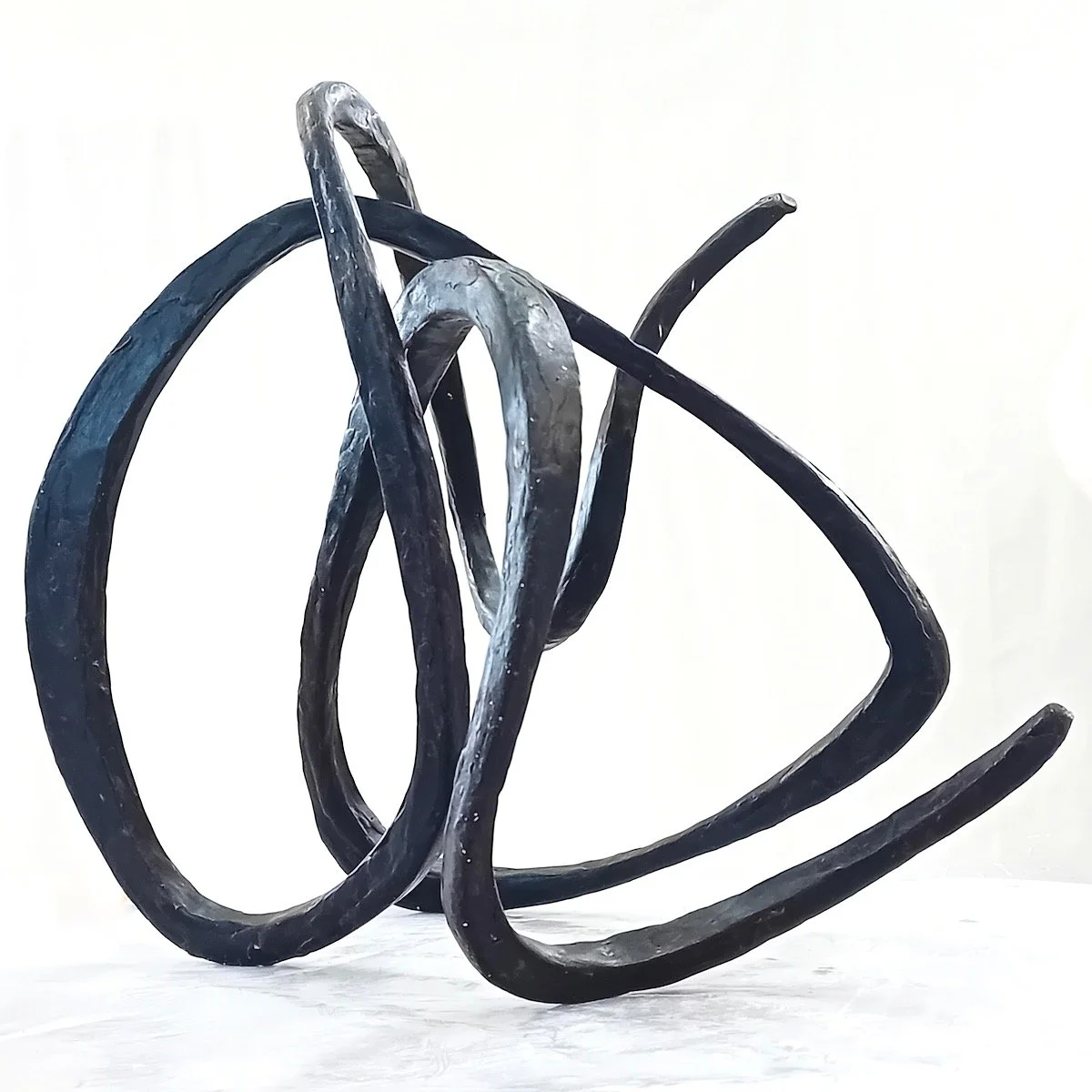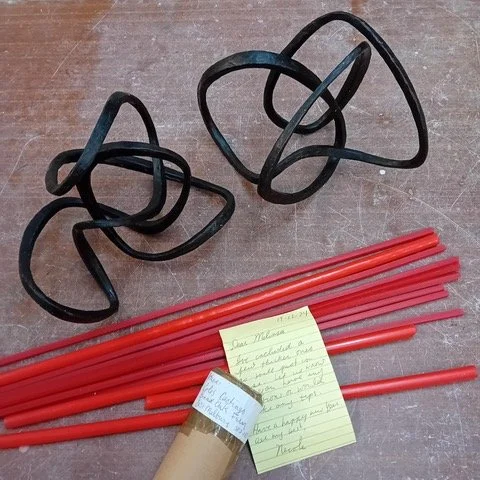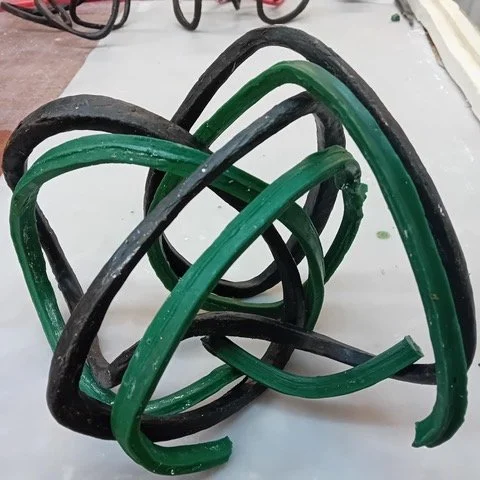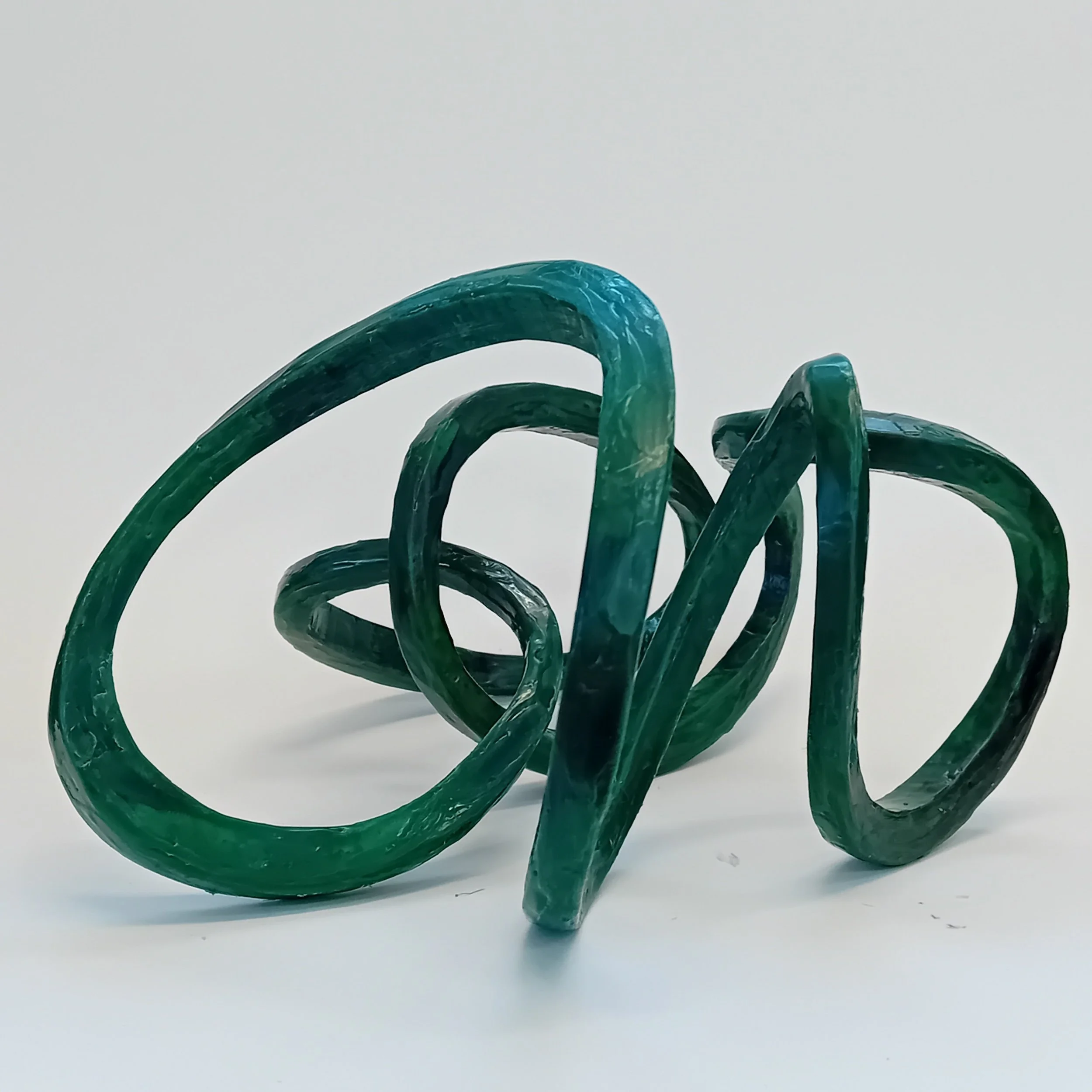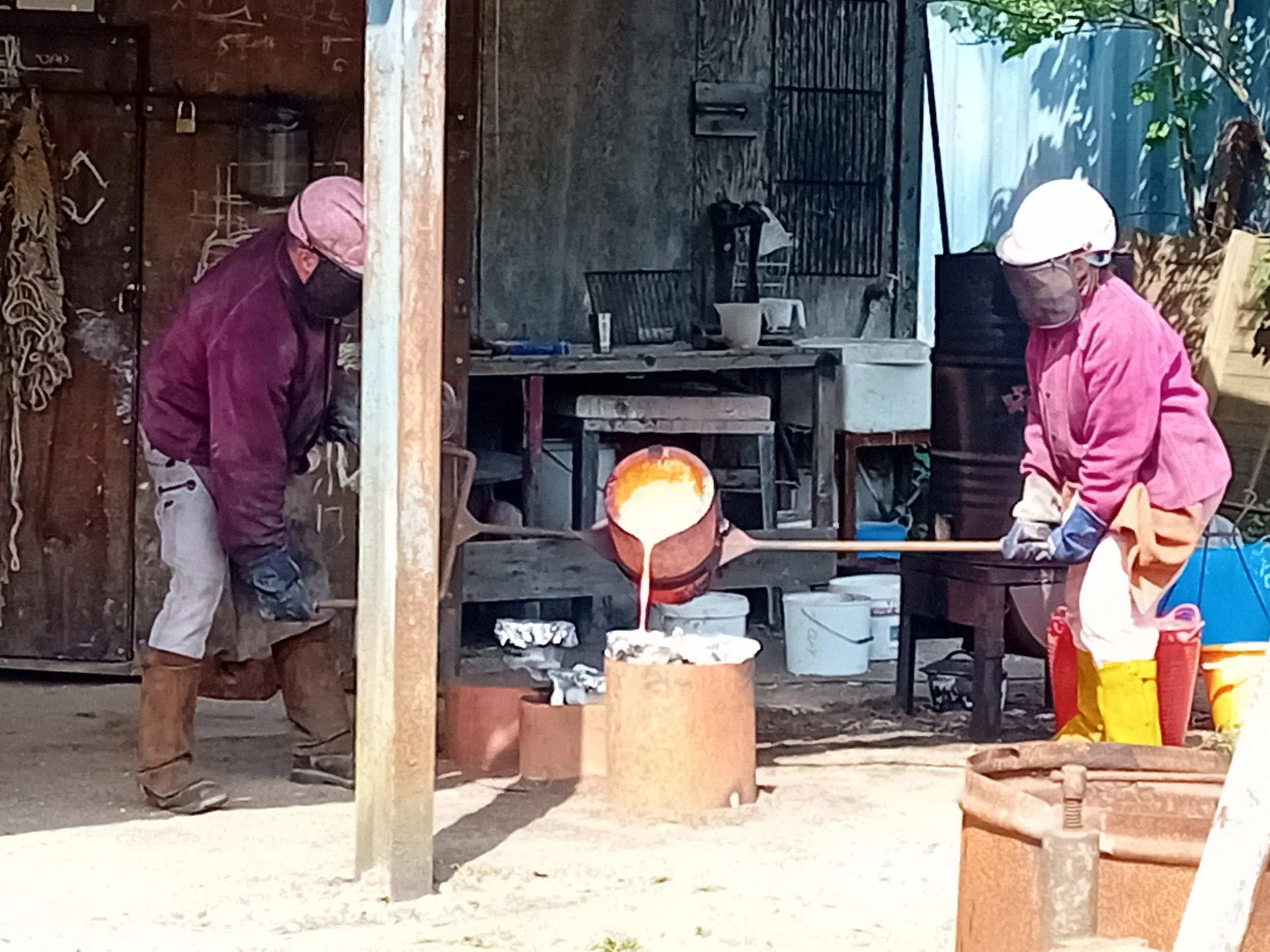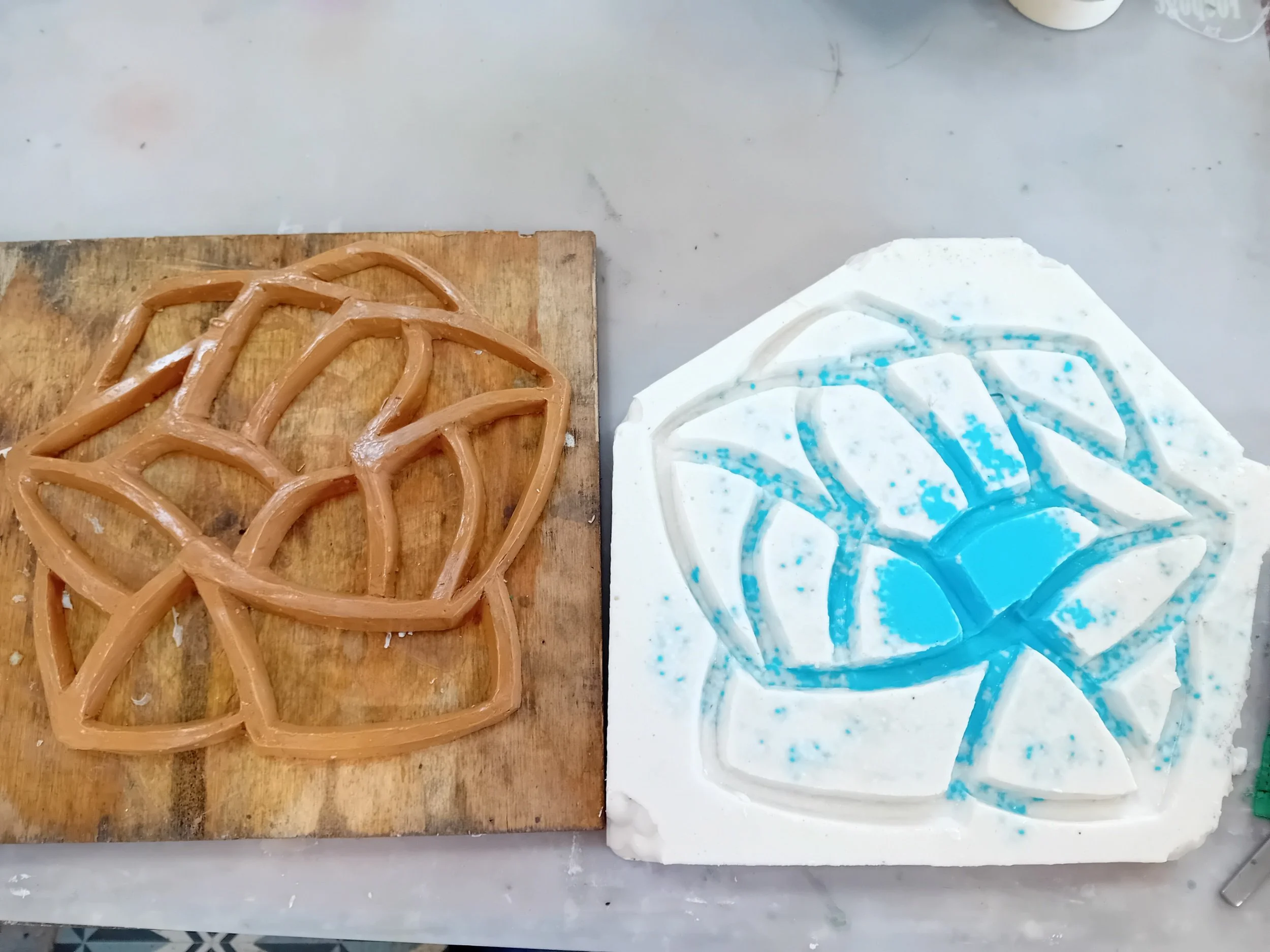I won the opportunity to have a small bronze sculpture cast at Coles Castings!
Coles Castings is a fine art foundry in North Dorset who specialise in bespoke works in cast iron, bronze and aluminium. They offer a range of foundry processes including lost wax in ceramic shell, silicon rubber mould making, traditional sand casting, metal finishing, and patination. Steve and Necole, the founders of Coles Casting, gave an online talk to members of the Royal Society of Sculptors, and I won the prize draw for a small bronze cast.
“…we are looking forward to working with you to cast a piece of your work. We thought it may be best if you could send over a few images or ideas of what you would like to do and then we can have a further conversation about how best to move forward in the process. “
December: Zoom Meeting and Initial Ideas
I had been developing some sculptures in wax which I wanted to cast, so was thrilled at this chance to meet Stephen and Necole, and show them my ideas. In the past I’ve had figurative bronzes (see commissions) cast using the ceramic shell process, but I was interested to learn techniques for casting these more complicated forms, and also to find out about sand casting.
To make a bronze, a silicon mold is made of the original sculpture, and the form is reproduced in wax. Wax rods or ‘sprues’ are attached to the wax copy, providing channels for the bronze to run into the mould during the ceramic shell casting process. The entire form is then encased in investment plaster or ceramic shell, the wax melted out, and the bronze poured back in. Making a mold of the original also allows you to make multiple casts of the same piece.
After looking at the complexity of the form and size of my sculptures, Steve and Necole thought it most suitable to work directly in wax and use the lost wax process, encasing the original in a plaster or ceramic shell investment, melting out the wax, and pouring bronze back into the resulting mold. My original forms were made using soft brown modelling wax over a steel armatures, which couldn’t be melted out. This meant I had to try to remake them, using wax only. However, I was interested to try out this direct method of working. This would cut out the intermediate step (and cost and complexity) of making a complex silicon mold, but I would only be able to make one unique, rather than multiple, casts. (It is possible to use a bronze wire armature, but I didn't experiment with that process this time.)
January: Experimentation and Frustration
“ Hi Necole…I received the wax and started back the studio last week and this week. It’s going.. difficultly. When I was initially working on these forms, I had been trying to work directly in wax, but found I couldn’t do what I wanted to do without the rigidity and flexibility of the steel armature. I was hopeful that wax you sent might work, but I haven’t yet managed it. Below is a little recounting of my efforts so far, so you can see what I’ve tried. I’d welcome your thoughts! Melissa “
Necole sent me long rods of red sprue wax, which she thought might be flexible enough to bend and shape, yet still rigid enough to hold the form. It took me a fair amount of experimentation and determination to figure out how to make these forms without the rigidity the metal armature provides. The curves of red wax tended to flop when I worked on them.
I made a long plaster mold to cast rods of even more rigid green casting wax, and bent them into shape as the rods were cooling. It was winter, and quite cold in the studio. If I warmed up the wax enough to be able to bend it, the entire form would ‘flop’ and not hold it’s shape. If I tried to adjust the curves without warming it, or tried to model or shape the surface of the forms, the cold wax would crack and fracture into pieces. In principle, is easy to melt the wax and stick pieces back together, but I lacked a sufficient number of arms and hands to hold all the pieces of these tangled forms in the correct positions. It was quite frustrating work.
February: Technique, Play and Refinement
However, Necole and Stephen were at hand to contribute expertise and ideas for working with wax, advising on tools, methods and techniques. I learned how to make ‘bog wax’, by kneading warm wax as it’s setting until it achieves a putty-like texture, which I could use to model. I experimented with building up forms using bog wax, then shaping the curves by using a metal knife heated in a propane flame. I worked on several pieces simultaneously, partly because I often work in multiples, but also so that when one form started to warm up and sag, I could put it aside to cool down and work on another. I even got good enough so that, when one day I came to the studio to find a wax sculpture smashed to pieces on the floor (I had hung it off the corner of a chair as the wax was was cooling and setting), I was able to puzzle it back together.
“At this point I am having so much fun! My mind is completely filled with tangled forms. Shaping, playing, drawing out the lines, trying out different surface topographies.
“What maximum thickness should I aim for (or not exceed)? And regarding surface finish- I am using a hot knife to melt and shape. I wish I could sand, but my rifflers or sand paper get clogged up. I seem to remember that methylated spirits soften the surface? I might try using a thin veneer of brown modelling wax.”
Having mastered the forms, I turned my attention to refinement of the shape and the surface texture. I was using a hot knife to melt the surface, and Necole suggested I could also try using wet/dry sandpaper or sanding mesh dipped in white spirits to dissolve and smooth the surface a bit. As these were to be cast solid, rather than as hollow forms, she advised that the diameter of the wax stayed within the 4mm to 12mm range, with gradual changes in thickness (rather than very thin next to very thick) to avoid bronze flow issues.
March: Studio Exhibition
“I want to cast them all! I want to try out colours- solid cobalt blue or vivid orange- and metals- bronze, aluminium, steel. I have so many other ideas I want to try, so many more forms. “
At this point I had created five wax forms, and wanted to cast them all. I weighed the wax and Coles Casting gave me quote for the price of casting each form. I could afford to cast one extra piece, for now. To help me choose which, I set up a studio exhibition, and included the original steel/brown modelling wax sculptures, alongside a series of related paintings. The paintings were created using ink over a beeswax resist.
April: Foundry Visit
“Looking forward to visiting and bringing the waxes down next week! I’ll aim to arrive after lunch on Wednesday and leave Thursday afternoon. Another question, I have a VW camper van. I can find a campsite to stay for the night, but I am quite self sufficient, so wondered if you have space at your foundry where I can park overnight?”
I
I drove from the flat Cambridge fenland to the Dorset countryside, passing Stonehenge along the way. I arranged with Steve and Necole to visit at a time when they were doing a bronze pour, so I could see the foundry in action and learn more about the processes they use. This would help me in designing ideas for future potential works. It’s not that I want my ideas to be constrained by processes, but there is a very practical side to making sculpture. It’s easy to have an idea but I think that sometimes the execution can be constrained by available techniques. I find that this understanding helps me work around potential limitations.
On the first day Necole and Steve were preparing works for the bronze pour the subsequent day. For the ceramic shell process, they dipped and coated, building up layers of the liquid slurry coated with sand. For the sand casting process, they packed damp sand about the original form. With tremendous flames leaping from the kiln, Steve burned out the wax of some previously completed ceramic shell coated pieces. While I worked on final finish details on my waxes, I badgered the two with questions and tried not to get in the way. Both gracefully and generously shared their knowledge and expertise as they worked.
On the the second day, Steve fired up the furnace while Necole shovelled sand into a row of tubs, then placed upside down ceramic shell jackets into each. The day was fiercely hot. When the crucible of molten bronze was ready, the two donned heavy leather jackets and gauntlets and kindly sent me to the edge of the yard, where I could watch from a safe distance- which I was happy to do, because the lucent metal looks terrifying like lava. After pouring the bright hot bronze in well-rehearsed choreography, Steve and Nicola smiled and shook hands. To celebrate remaining in possession of theirs, I think.
Sand Casting
I’ve always been interested in translating ink line drawings into metal sculptures and I was interested in developing works suitable for sand casting, a relatively more simple process.
While at the foundry, I started modelling a flat piece in clay, and asked Steven about ways make it easiest to cast. I was working in clay, but ideally the original would be in a harder/more rigid medium, and the form flat, no undercuts, no huge changes in thickness. Back in my studio, I completed this piece, made a silicone mold and cast into jesmonite. I brought this back to the foundry at a later date for them to cast.
May: Foundry Casting
I left the waxes at the foundry to attach risers/runners, invest in ceramic shell, and include in the next bronze pour. (Pictures? ask Necole) In the meantime, I prepared for my next adventure…
June: Artist in Residence- Mondamin Summer Camp, North Carolina
“I saw that you were doing a community bronze pour a few weeks ago, when I was still in the US. Looked exciting! I’m just back now, after a busy and exhilarating time, including leading waterfall drawing/ swimming mountain hikes, and welding oversized insects (spider, lightning bug, cricket and bumble bee) to join the camp activities.”
At this point I headed off to North Carolina, where I spent a month drawing, teaching and welding at the Mondamin Summer Outdoor Camp (see Summer Camp blog posts).
July: Patination
“I want to try two contrasting patinations- maybe one blueish and one greenish- but a bit of experimentation for me.“
I tend to use the colour of the materials I work with. When I do add colour, I treat it as a sculptural element. With these works, I wanted to try out two contrasting patinas. First we prepped the bonzes, smoothing away any surface blemishes from the casting process, and adding back details from the areas where the sprues had been cut off. I say “we”: I did the easy work of sanding and riffling, and Necole, the more laborious and technically challenging work of grinding texture into the bronze. The works were sand blasted, and then Steve mixed the acids (Ferric Nitrate, Liver/Potash, Marble White, Cupric Nitrate). He heated the bronzes with a propane torch and bit by bit added the colour using a paintbrush dipped in the acid. For one bronze, I went for a traditional treatment of Ferric, Cupric, and White, which provides a more dramatic mottled green finish, and with the other, by contrast, the solid black of the Liver/Potash, which highlights the sculptural form.
August: Hatching Plans
So I’m back in Cambridge now, enjoying my bronzes and planning for an exhibitions and developing new works. Necole and Stephen have been so helpful and generous with their time and knowledge. I am incredibly grateful to Coles Casting and to the Royal Society of Sculptors for this opportunity.
Reflections
In the past, I undertook private commissions for works in bronze, steel and stone. In more recent years, I’ve focused on large scale, interactive, transient, or performative artworks. This event-based, temporary work is tremendously exciting, and to creates opportunities for viewers to engage with my work ‘thinkingly’, and gives viewers a creative role. However these artworks are difficult to exhibit or sell.
In making these bronze tangles, I wanted to create permanent artworks suitable for interior or domestic environments and exhibitions which retained the interest and dynamism of my large scale interactive artworks. These tactile bronzes have no ‘right way up’, and can be variously positioned, and the lines of their open forms take on myriad relationships as the viewer moves about the sculpture.
My plans are develop more works like these for sale and exhibition, and also to help public art commissioners better envisiage how my ideas will look on a monumental scale.
